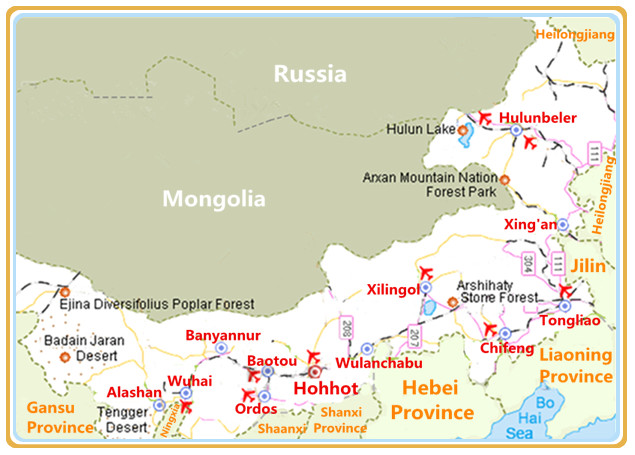- Home
- Province Guide > Inner Mongol >
Inner Mongolia Overview

Inner
Mongolia Autonomous Region meets
Mongolia and Russia to the north. Extending along nearly all the northern region of China, Inner Mongolia is a province level region in China that has the widest span of longitude. Inner Mongolia is not only rich in natural landscapes, but houses strong ethnic local culture.
The vast prairie is mainly located in western Inner Mongolia. Grassland is the very symbol of Inner Mongolia and it has long been the place that people pay tribute to and crave for. “Vast is the sky, boundless the wilds; sheep and cattle will emerge before your eyes.” “The beautiful grassland is my home; green grasses and colorful flowers are just like a carpet flowing with the blow of the wind.” “In the bluish sky float whitish cloudlets and beneath the whitish clouds gallops a drove of horses.” All these poetic and picturesque descriptions have long satisfied people’s yearning for visiting the grasslands. The Hulun Buir Prairie, Siklingelei Prairie and such pasture as Xilamuren Pasture are the best places to experience grasslands. In the pure and bright sky float low cloudlets; the vast and lush grasslands are scattered with white yurts; the air is all fresh; flocks and herds are everywhere. For the people that have long lived in the cities, they will be amazed by the scenery the grasslands have to offer.
The desolate desert covers the western region of Inner Mongolia. The desert is so distinctive that its scenery is magnificent. Deserts like the Badanjilin Desert-the most beautiful desert in China, the Tenggeli Desert and the Sand Resounding Bay in the Kubuqi Desert are swarming with a mysterious flavor of the northern-frontier scenery; the oases and lakes in the deserts are precious landscapes that won’t fail to attract visitors attention. Additionally, the poplar forests in Ejina, the ice stone forests in Asihatu, the vast stretch of forests in Aer Mountain and the vast Hulun Lake are representative of superb craftsmanship in nature.
The Mongolian was a nomadic group in the past. They made a living by grazing and hunting, thus granting them the name “a nation on the horseback.” The local people are simple and hospitable and they have maintained the most traditional and distinctive customs. The yurts, Nadam Fair and the local costumes are completely different from those inland. Inner Mongolia is also home to “the Proud Son of Heaven”-Genghis Khan and the place through which Lin Zhaojun went the west frontier region. Such dynasties as the Liao, Jin and Yuan once contended for political power in this land. It’s in Inner Mongolia that the Mongolia Empire gained its rise to power. There are a myriad of places of interest in Inner Mongolia, including: the Genghis Khan Tomb, Zhaojun tomb, Wudang Temple, Xilitu Temple and the
Shangjing historical site of the
Jin Dynasty, etc.
 Inner Mongolia Autonomous Region meets Mongolia and Russia to the north. Extending along nearly all the northern region of China, Inner Mongolia is a province level region in China that has the widest span of longitude. Inner Mongolia is not only rich in natural landscapes, but houses strong ethnic local culture.
Inner Mongolia Autonomous Region meets Mongolia and Russia to the north. Extending along nearly all the northern region of China, Inner Mongolia is a province level region in China that has the widest span of longitude. Inner Mongolia is not only rich in natural landscapes, but houses strong ethnic local culture. Ask Questions ?
Ask Questions ?